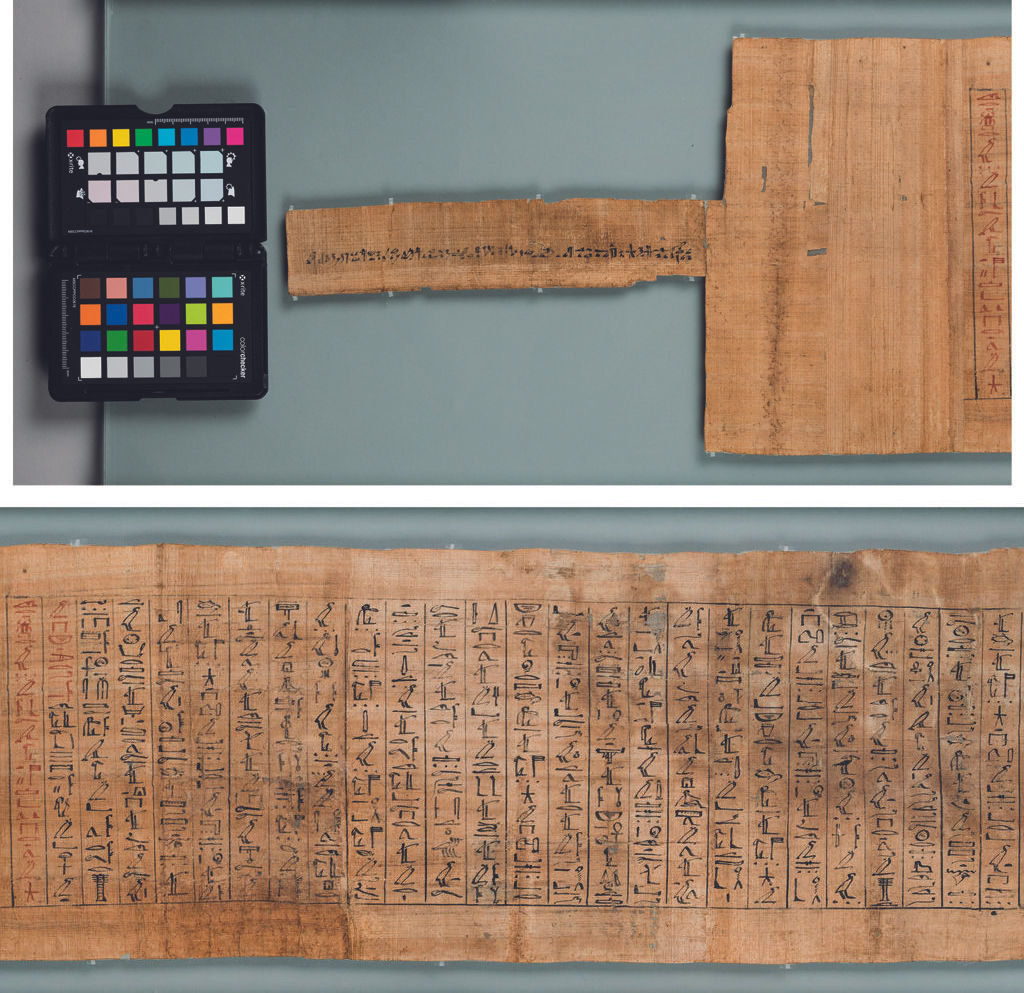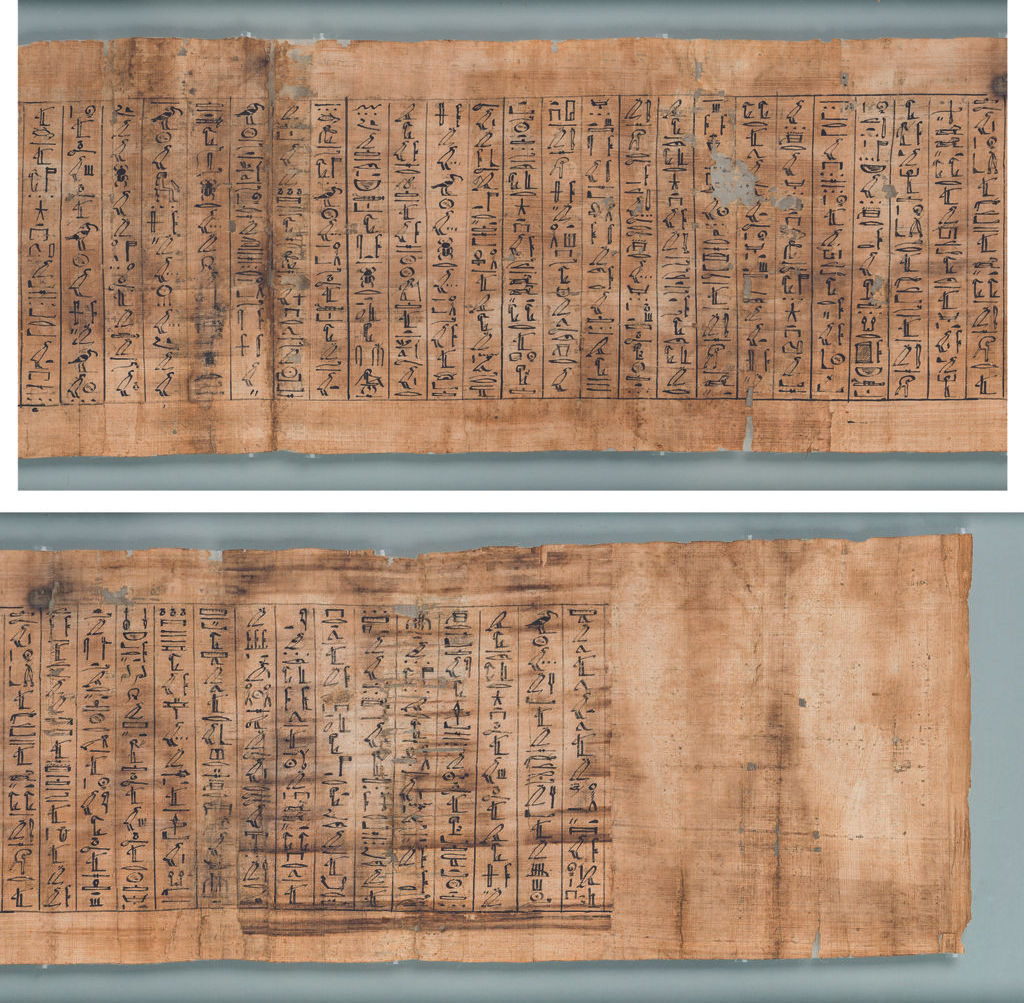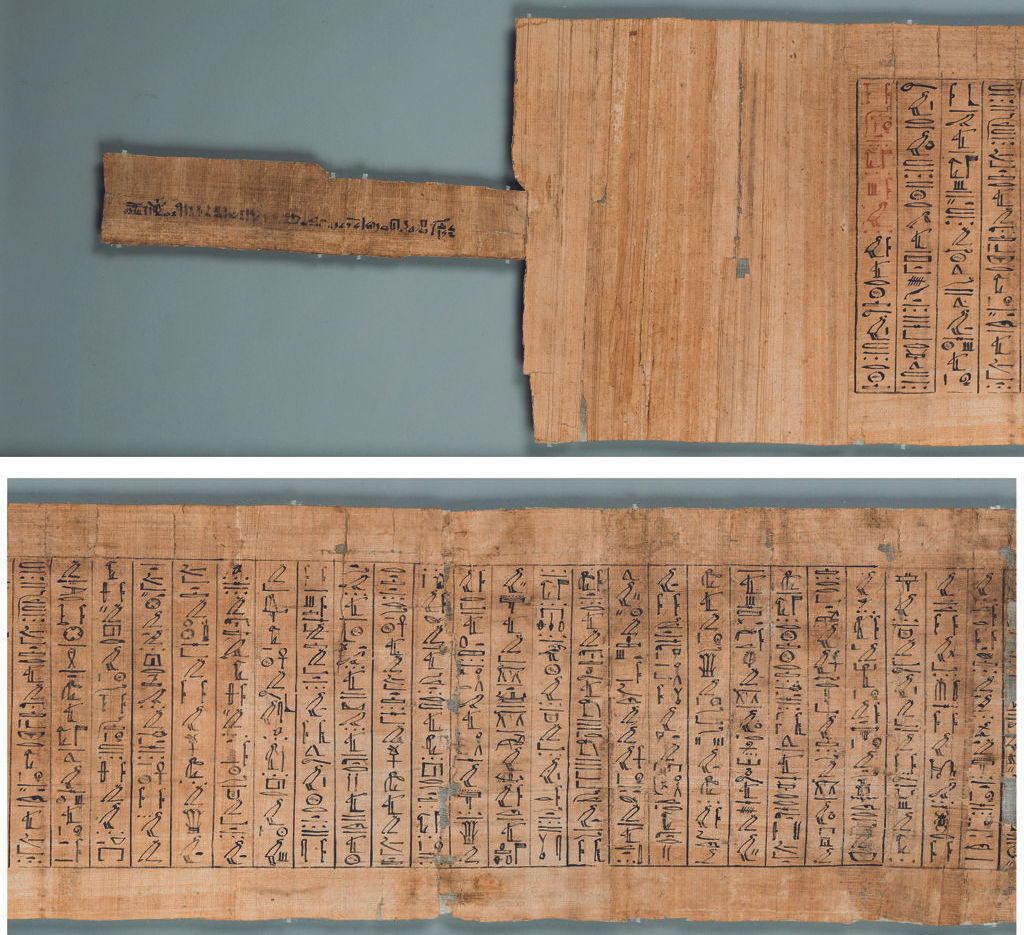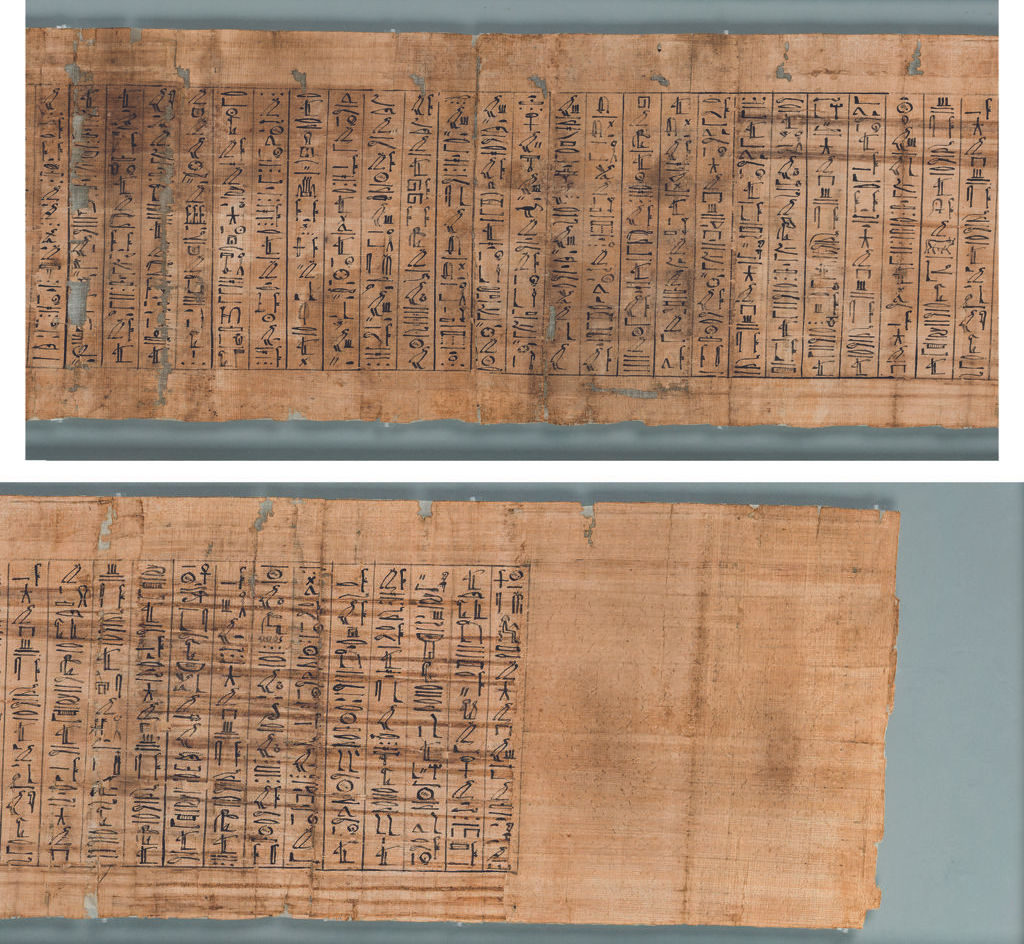Abstract
Publication of two hieratic titles for the Book of the Dead appended to two complete New Kingdom papyri inscribed with extracts of BD 78 (P. Turin Cat. 1828/2) and BD 125 (P. Turin Cat. 1828/1), respectively. The author argues that the titles are not contemporary with the two papyri and that the manuscripts were made from a longer roll that was appropriated at a later date and cut into two or more sections.
Introduction
The title of the “Book of Dead” or “Book of Going out in Daylight” has been discussed numerous times and translated in various ways. These studies have made it evident that no “canonical” title for the composition existed in the New Kingdom.1 In this article, two titles for the Book of the Dead that are important for the transmission history of the composition are discussed.2 They have been known since the time of Edouard Naville, but their import has not been appreciated, likely because his description of the two papyri in Turin on which they are appended was misleading. In the Swiss scholar’s introduction to his fundamental study of the Book of the Dead in the New Kingdom, they are presented in the following manner:3
From his description it is not evident that the two “especially well-preserved pieces” (vorzüglich erhaltene Stücke) are actually complete rolls (Fig. 1, Fig. 2). They were written for the same owner, Khonsumes, who was a wab-priest and chief of weighers in the temple of Amun.5 The hieroglyphic writings of his name and titles are the following:
- Name: Khonsumes
-
a.

(P. Turin Cat. 1828/2, line 3) -
b.

(P. Turin Cat. 1828/1, line 65) 2
- Title 1: Wab-priest
-

(P. Turin Cat. 1828/2, line 2; P. Turin Cat. 1827/1, line 64)
- Title 2: Chief of weighers in the temple of Amun
-

(P. Turin Cat. 1828/2, line 2; P. Turin Cat. 1828/1, line 64)
Nothing is known about the original provenance of the two papyri or the circumstances under which they were found, except that they were acquired by the government of Piedmont in 1823–1824 as part of Bernardino Drovetti’s collection.6 Like most of the papyri in the Museo Egizio collected by Drovetti and his agents, they probably come from Thebes. The information provided by Naville that they were discovered during the unravelling of a mummy should be taken cum grano salis, but the dark brown discoloration of the sheets might testify to the truth of his statement.7
Description of the papyri
The texts on both rolls were written vertically in retrograde hieroglyphs framed by lines. They were penned by the same scribe and inscribed against the sheet joins, i.e., the texts are written from the end of the roll towards the beginning (from left to right). The first roll (P. Turin Cat. 1828/2 – Fig. 1) measures c. 24 × 181 cm and contains an abbreviated version of BD 78 in 64 columns.8 The second roll measures c. 24 × 186 cm (P. Turin Cat. 1828/1 – Fig. 2) and is inscribed with the closing speech of BD 125 in 65 columns.9 At the beginning and end of both rolls, protective sheets are affixed, made from eight smaller strips glued two by two to the beginning and end of the rolls. The strips at the beginning and end of the first manuscript have a width of c. 24 × 11, × 9.5, × 7 and × 7 cm (from right to left). The strips of the second roll c. 24 × 11, × 10.5, × 7.5 and × 9.5 cm. It is clear that some of the protective sheets were added to the first roll after the frame had been drawn, since the top and bottom lines that hem in the last column continue underneath the protective sheet. In the second roll, the last column (and hence, we can assume, the whole text) was inscribed after this protective sheet had been added, since the hieroglyphs just barely overlap the edge of the strip. The inscribed parts of the two papyri consist of 7 sheets each with an average width of c. 20.5–21 cm.
P. Cat. 1828/2. Photo by Nicola Dell’Aquila/Museo Egizio.
P. Turin Cat. 1828/1. Photo by Nicola Dell’Aquila/Museo Egizio.
The date of the papyri cannot be established with any great certainty. Naville and Munro agree in assigning them to the Ramesside Period.10 The texts are austerely abbreviated. On the first roll, BD 78 ends in the middle of the chapter with the sentence:
-

(P. Turin Cat. 1828/2, line 64) -
iw 1r Hr s.t=f -
“Horus is upon his seat.”
3
The second roll begins with the closing speech of BD 125(c) and ends, after reciting about two thirds of the known text, with the otherwise unattested addition that Khonsumes is:
-

(P. Turin Cat. 1828/1, line 65) -
mAa xrw m sbA pw aA n.t imn.tyw - “justified in this great gate of the Westerners.”11
Although abbreviated, the texts are flawlessly written; only a few random mistakes can be detected, such as the omission of a sign. Apart from the first line(s), the two texts are written in black. The rubric passage of the first roll reads:
-

(P. Turin Cat. 1828/2 lines 1–2) -
ir.t xpr.w m bik nTry aq pr.t m dwA(.t) nb.t mr(r)=f in - “Assuming the forms of a divine falcon and going in and coming forth from every cavern as he desires, by…” The addition, “going in and coming forth from every cavern as he desires” is otherwise unattested in both BD78 and the corpus as such.12
The rubrum of the second roll reads:
-

- (P. Turin Cat. 1828/1, line 1)
-
inD-Hr.Tn nTr.w ipw - “Hail to you, ye gods!”
It is noteworthy that the passages are not introduced, as is normally the case, by the headings “chapter” (
The two titles
The two hieratic titles mentioned by Naville are inscribed in the middle of two strips of papyrus both measuring 5 × 24 cm. It is clear from gaps between the strips and the two papyri that they were joined horizontally to the beginning of the manuscripts in modern times, likely when, at an unknown date, they were unrolled and mounted on Lyon silk and cardboard.13
Their length, conforming to the height of the rolls, and the fibres and cuts along the upper and lower edges of the strips clearly show that they were excised in antiquity from the protective sheets of the papyri. It is likely that they were used as labels glued to the rolls, most likely along their outer edge.14 As an alternative, they might have been used to bind the rolls: in this case, the uninscribed ends of the strips would have been glued together. Assuming an overlap of 1–1.5 cm, to be subtracted to the 24-cm circumference of the band encircling the roll, the rolled-up papyrus would have had a diameter of slightly more than 7 cm. The strips would thus have been long enough to bind the rolls. In either hypothesis (labels or binding strips), the titles written upon the strips would have served a practical purpose, namely, to facilitate consultation by the mortuary priest, who would be thus informed about the content of the papyri without having to unroll them.15
Both titles were penned by the same scribe and are written from right to left in a minute hieratic book hand. The palaeography of the two titles could indicate that they were penned during the late Ramesside Period or the Third Intermediate Period, but too little text is inscribed on the strips for palaeographical considerations to be diagnostic.16 They can be transcribed, transliterated and translated as follows:17
- Title 1 (P. Turin Cat. 1828/2 – Fig. 3)
P. Turin Cat. 1828/2 – title. Photo by Nicola Dell’Aquila/Museo Egizio.
-

-
tA mDA.t aA.t imy(.t) dwA.t nty ∅ (Hr) ir.t=s n Ax.w nb{.t}(.w) iqr(.w) r tm rdi.t sxm xfty.w nb n imn.tt im=f m Ss mAa 4 - “The great book ‘What Is in the Netherworld’, which was made for every excellent transfigured spirit in order to prevent the enemies of the Lord of the West from having power over him, (as) a truly excellent (thing)”.
- Title 2 (P. Turin Cat. 1828/1 – Fig. 4)
P. Turin Cat. 1828/1 – title. Photo by Nicola Dell’Aquila/Museo Egizio.
-

-
tA mDA.t pr(.t) m hrw nty tw.t(w) (Hr) ir(.t)=s n Ax.w nb(.w) iqr(.w) m Ss mAa r HH n sp - “The book ‘Going Forth by Day’, which was made for every excellent transfigured spirit as a truly excellent (thing) for a million times”.
Unlike the manuscripts unto which they are appended, the titles are written in Late Egyptian. This is evidenced by the use of the definite article at the beginning of both titles and the use of the construction
Conclusion
Since both titles are unattested and no similar short versions of the Book of the Dead dating from the New Kingdom have been found so far, it is difficult to properly evaluate the role that the two manuscripts played in the history of the transmission of the composition. In my opinion, two scenarios can be envisaged:
-
The titles are contemporary with the manuscripts and an example of the ad hoc genesis of the Book of the Dead. As such, the papyri would be an early example of a “tomb-library” consisting of two or more funerary papyri.18 This would entail that the modern title “Book of the Dead”, besides designating a collection of “chapters” or “spells” (
r.w ), also denotes a collection of “books”. -
The titles are not contemporary with the manuscripts and the papyrus scrolls were made from an older roll that ended with the closing speech of BD 125. At a later date, this manuscript was appropriated, cut into two or more sections and new protective sheets added. Indicative of this procedure is the abrupt ending of chapter BD 78 (P. Turin Cat. 1828/2) in the first roll
5 and the trimmed edge preceding the first column of the second roll (P. Turin Cat. 1828/1).
I find the second scenario more plausible, because the titles are written in Late Egyptian and begin “the great book ‘What Is in the Netherworld’…” (
Bibliography
Al-Ayedi, Abdul Rahman, Index of Egyptian Administrative, Religious and Military Titles of the New Kingdom, Ismailia 2006.
Backes, Burkhard, “ʻWas zu sagen ist’ – zum Gesamttitel des Totenbuchs”, in: Burkhard Backes, Marcus Müller-Roth and Simone Stöhr (eds.), Ausgestattet mit den Schriften des Thot. Festschrift für Irmtraut Munro zu ihrem 65. Geburtstag (SAT 14), Wiesbaden 2009, pp. 5–27.
Burkard, Günter and Hans-Werner Fischer-Elfert, Ägyptische Handschriften, IV (VOHD 19/4), Stuttgart 1994.
Christiansen, Thomas and Kim Ryholt, The Carlsberg Papyri 13: Catalogue of Egyptian Funerary Papyri in Danish Collections (CNI Publications 41), Copenhagen 2016.
Cooney, Kathlyn M., “Coffin Reuse: Ritual Materialism in the Context of Scarcity”, in: Alessia Amenta and Hélène Guichard (eds.), Proceedings First Vatican Coffin Conference 19-22 June 2013, Vatican City 2017, pp. 101–12.
Daressy, Georges M., “Les cercueils des prêtres d’Ammon (deuxième trouvaille de Deir el-Bahari)”, ASAE 8 (1908), pp. 3–38.
Das altägyptische Totenbuch – Ein digitales Textzeugenarchiv, http://totenbuch.awk.nrw.de/.
Fabretti, Ariodante, Francesco Rossi and Ridolfo V. Lanzone, Regio Museo di Torino: Antichità Egizie (Catalogo generale dei musei di antichità e degli oggetti d’arte raccolti nelle gallerie e biblioteche del Regno, Serie Prima – Piemonte I), I, Torino 1882.
Hagen, Fredrik, “Libraries in Ancient Egypt c. 1600–1000 BC”, in: Kim Ryholt and Gojko Barjamovic (eds.), Libraries Before Alexandria, Oxford forthcoming.
Herzberg, Anne, “Zu den memphitischen Grabreliefs in der Sammlung des Ägyptischen Museum – Georg Steindorff – der Universität Leipzig”, ZÄS 143 (2016), pp. 34–59.
Lapp, Günther, Totenbuch Spruch 125 (TbT 3), Basel 2008.
Lapp, Günther, Die
Lüscher, Barbara, Die Verwandlungssprüche (Tb 76–88) (TbT 2), Basel 2006.
Lüscher, Barbara, Auf den Spuren von Edouard Naville (Totenbuchtexte Supplementa 1), Basel 2014.
Martin, Cary and Kim Ryholt, “Put My Funerary Papyri in My Mummy, Please”, JEA 92 (2006), pp. 270–74.
Moiso, Beppe, La storia del Museo Egizio, Torino 2016.
Munro, Irmtraut, Untersuchungen zu den Totenbuch Papyri der 18. Dynastie: Kriterien ihrer Datierung (StudEgypt), London and New York 1988.
Naville, Edouard, Das aegyptische Todtenbuch der XVIII. bis XX. Dynastie, I–III, Berlin 1886.
Niwiński, Andrzej, Studies on the Illustrated Theban Funerary Papyri of the 11th and the 10th Centuries B.C. (OBO 86), Freiburg 1989.
Rammant-Peeters, Agnes, Les pyramidions égyptiens du Nouvel Empire (OLA 11), Leuven 1983.
Ryholt, Kim, “A Decorated Band for Tying a Papyrus Roll”, in: Kim Ryholt (ed.), The Carlsberg Papyri 7: Hieratic Texts from the Collection (CNIP publications 30), Copenhagen 2006.
Schott, Siegfried, Bücher und Bibliotheken im alten Ägypten: Verzeichnis der Buch- und Spruchtitel und der Termini technici, Wiesbaden 1990.
Verhoeven, Ursula, Untersuchungen zur späthieratischen Buchschrift (OLA 99), Leuven 2001.
Vleeming, Sven Peter, Demotic and Greek-Demotic Mummy Labels and Other Short Texts Gathered from Many Publications (StudDem 9), Leuven 2011.
P. Turin Cat. 1828/2. Above: Title and Col. 1. Below: Cols. 1–26.
P. Turin Cat. 1828/2. Above: Cols. 26–50. Below: Cols. 50–64.
P. Turin Cat. 1828/1. Above: Title and Cols. 1–4. Below: Cols. 4–27.
P. Turin Cat. 1828/1. Above: Cols. 27–50. Below: Cols. 50–65.
Notes
- The fundamental study of the title of the Book of the Dead is Backes, in Backes et al. (eds.), <i>Ausgestattet</i>, 2009, pp. 5–27; the two titles discussed in this paper do not feature in his survey, likely because there are no pictures of the two papyri in the “Totenbuch Archiv”, <i>Totenbuchprojekt Bonn, TM 134384</i>, <a href="http://totenbuch.awk.nrw.de/objekt/tm134384">totenbuch.awk.nrw.de/objekt/tm134384</a> (last accessed 08/06/2018). For the title in the New Kingdom and the Third Intermediate Period, see Lapp, <i>Die</i> <named-content content-type="traslitterazione">prt-m-hrw-</named-content><i>Sprüche</i>, 2011, pp. IX–XVIII, where the two papyri are mentioned on pp. XII–XIII.↑
- I am grateful to Ann Katrin Gill, Lena Tambs and Dora Petrova Olsen for reading and commenting upon an early draft of this article, and to Stéphane Polis for his sharp eye. My thanks also go out to the two anonymous reviewers for their very helpful corrections, suggestions and remarks to the submitted article.↑
- The genesis of the study is told in Lüscher, <i>Auf den Spuren</i>, 2014.↑
- Naville, <i>Todtenbuch</i>, I, 1886, p. 88.↑
- The latter title is, to my knowledge, rarely attested; compare <named-content content-type="traslitterazione">Hry iry-mxA.t n pr-Hd</named-content>, Herzberg, <i>ZÄS</i> 143 (2016), pp. 40–44. Further <named-content content-type="traslitterazione">iry-mxA.t</named-content> (+ institution) in Al-Ayedi, <i>Index</i>, 2006, p. 164; Rammant-Peeters, <i>Les pyramidions</i>, 1983, p. 68.↑
- For the history of the Drovetti collection, see Moiso, <i>Museo Egizio</i>, 2016, pp. 40–55.↑
- Corroboration of Naville’s claim is found in Fabretti et al., <i>Regio Museo di Torino</i>, I, 1882, p. 224, where it is stated that the papyri were found in the bandages of a mummy, whose skeleton was displayed in the museum (“due papiri funerarii… trovati fra le fascie della mumia, da cui fu tratto lo scheletro esposto nella seconda sala …”). The skeleton in question is Cat. 2250, whose present whereabouts in the museum are unknown; cf. Fabretti et al., <i>Regio Museo di Torino</i>, I, p. 319. For funerary compositions inserted amongst mummy wrappings, see Martin and Ryholt, <i>JEA</i> 92 (1996), pp. 270–74.↑
- Transcribed by Naville, <i>Todtenbuch</i>, II, 1886, pp. 164–69 (Ij); Lüscher, <i>Die Verwandlungssprüche</i>, 2006, pp. 33–117 (pT2).↑
- Transcribed by Naville, <i>Todtenbuch</i>, II, 1886, pp. 310–29 (Ij).↑
- Naville, <i>Todtenbuch</i>, I, 1886, pp. 88–89; Munro, <i>Untersuchungen</i>, 1988, pp. 307–08; further Lüscher, <i>Die Verwandlungssprüche</i>, 2006, p. XXIX.↑
- For the context, confer Naville, <i>Todtenbuch</i>, II, 1886, p. 329; further Lapp, <i>Totenbuch Spruch</i> 125, pp. 256–57, who does not include P. Turin 1828/1 in his synopsis. I am grateful to René Van Walsem for his suggested reading of <named-content content-type="traslitterazione">sbA</named-content> instead of <named-content content-type="traslitterazione">dwA.t</named-content> in this book title.↑
- Cf. Lüscher, <i>Die Verwandlungssprüche</i>, 2006, p. 33.↑
- Today, the cardboard backing has been removed and the manuscripts are mounted in two glasses instead of one.↑
- For a decorated band for tying a papyrus roll from the Roman Period, see Ryholt, in Ryholt (ed.), <i>Hieratic Texts</i>, 2006, p. 159.↑
- Another attestation of such a strip might be the fragment pBerlin P. 23075 from the late Eighteenth Dynasty, where the title <named-content content-type="traslitterazione">pr.t m hrw</named-content> is inscribed horizontally in the middle of the papyrus, cf. Burkard and Fischer-Elfert, <i>Äg. Handschriften 4</i>, p. 148; Lapp, <i>Die</i> <named-content content-type="traslitterazione">prt-m-hrw-</named-content><i>Sprüche</i>, 2011, p. XII.↑
- Compare the hand to the first column in Verhoeven, <i>Untersuchungen</i>, 2001, pp. 102–211.↑
- A transcription and translation were provided by Naville, <i>Todtenbuch</i>, I, 1886, pp. 88–89; the transcriptions were republished by Schott, <i>Bücher</i>, 1990, pp. 96 (169), 101 (183); only the opening words of the two titles are transcribed/transliterated and translated in Fabretti et al., <i>Regio Museo di Torino</i>, I, 1882, p. 224 and Lüscher, <i>Die Verwandlungssprüche</i>, 2006, p. XXIX.↑
- For “tomb libraries” in the New Kingdom, see Hagen, in Ryholt and Barjamovic (eds.), <i>Libraries</i>, forthcoming.↑
- Niwiński, <i>Studies</i>, 1989, pp. 104–09; in none of the titles from the New Kingdom collected by Backes is the word for “book” (<named-content content-type="traslitterazione">mDA.t</named-content>) preceded by the definite article (<named-content content-type="traslitterazione">tA</named-content>), see Backes, in Backes, Müller-Roth and Stöhr (eds.), <i>Ausgestattet</i>, 2009, pp. 9–18.↑
- For examples of Third Intermediate Period papyri placed between the legs of the mummy, see Daressy, <i>ASAE</i> 8 (1908), pp. 23–38.↑
- Niwiński, <i>Studies</i>, 1989, p. 107. The practice of writing the title(s) on the edge of the verso, which allowed the mortuary priest to identify the compositions without unrolling them, is already attested in a Book of the Dead manuscript from the Eighteenth Dynasty, Lapp, <i>Die</i> <named-content content-type="traslitterazione">prt-m-hrw-</named-content><i>Sprüche</i>, 2011, p. XII.↑
- For the reuse of New Kingdom (and contemporary) coffins in the Third Intermediate Period, see Cooney, in Amenta and Guichard (eds.), <i>Proceedings First Vatican Coffin Conference</i>, 2017, pp. 101–12.↑
- That the name at least in certain instances was inconsequential for the ritual use of “Books of the Dead” is shown by manuscripts were <named-content content-type="traslitterazione">mn</named-content> (“someone”) is substituted for the name of the owner of the burial goods, <i>e.g.</i> pBritish Museum EA 10098 and 10844, where the bitumen on the manuscripts clearly show that they were interred with a mummy, see <i>Totenbuchprojekt Bonn, TM 57041</i>, <a href="http://totenbuch.awk.nrw.de/objekt/tm57041">totenbuch.awk.nrw.de/objekt/tm57041</a> (last accessed 06/08/2018). Likely, these Late Period/Ptolemaic manuscripts were reused master copies. See also P. Turin Cat. 1795, where the blank spaces for the name(s) were never filled in, most likely a reused made to stock Book of the Dead scroll. The same phenomenon can be observed in Demotic funerary papyri written for <named-content content-type="traslitterazione">mn</named-content> born of <named-content content-type="traslitterazione">mn</named-content>, see Vleeming, <i>Demotic and Greek-Demotic Mummy Labels</i>, pp. 689–90; further Christiansen and Ryholt, <i>Catalogue</i>, 2016, p. 32, pl. 106. ↑










